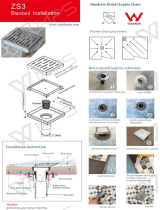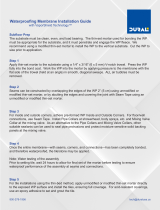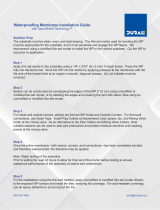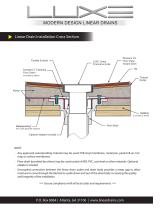
INNOVATIVE SOLUTIONS FOR CERAMIC AND STONE TILE
BONDED WATERPROOF MEMBRANES AND VAPOR RETARDERS
Ceramic and stone tiles are durable, easy
to maintain, and hygienic, representing
ideal surface coverings in wet areas.
However, since tiles and grout are not
inherently waterproof, it is essential to
protect the substrate from moisture
penetration.
Application and Function
8.1 Schluter
®
-KERDI is a pliable, sheet-
applied, bonded waterproof membrane and
vapor retarder with limited crack-bridging
capabilities. It is made of soft polyethylene,
which is covered on both sides with a
special fleece webbing to anchor the
membrane in the thin-set mortar.
KERDI was developed as a waterproofing
membrane to be used in conjunction with
ceramic and stone tile coverings. Tiles can
be installed directly on KERDI using the thin-
bed method. Other trowel-applied covering
materials, such as plaster, can also be used.
Schluter
®
-KERDI-DS is a bonded
waterproofing membrane and vapor
retarder with very low water vapor
permeance for use in continuous use steam
rooms and similar applications.
Various KERDI waterproofing accessories
are available. Use KERDI-BAND, in widths
of 5" (12.5 cm), 7-1/4" (18.5 cm), or 10"
(25 cm) to seal butt joints or corner joints.
KERDI-FLEX, in 5" (12.5 cm) or 10" (25 cm)
widths, is used to seal expansion joints or
flexible edge joints.
Preformed, seamless corners include the
following. KERDI-KERECK-F are used to
seal 90° inside and outside corners. KERDI-
KERS-B are used to seal 135° corners at
triangular shower benches and neo-angle
shower curbs. KERDI-KERS are used to
seal floor/wall/shower base connections
in curbless shower applications where the
KERDI-LINE linear drain is installed adjacent
to the wall.
KERDI-SEAL-PS/-MV are prefabricated
sections of KERDI with overmolded rubber
gaskets that are used to seal pipe protrusions
through the KERDI waterproofing membrane
(e.g., at showerheads and tub spouts) and
protect moisture-sensitive backing panels
at the mixing valve.
Material Properties and
Areas of Application
KERDI features a modified polyethylene
(PEVA) core with non-woven polyproplyene
on both sides. KERDI-DS features a high-
density polyethylene (HPDE) core with non-
woven polyproplyene on both sides. The
material is physiologically safe and does
not require special disposal. KERDI is 8-mil
thick and has a water vapor permeance
of 0.90 perms, when tested according to
ASTM E96, using Procedure E at 90%
relative humidity. KERDI-DS is 20-mil thick
WATERPROOFING MEMBRANES
8.1 Schluter
®
-KERDI
8.1 Schluter
®
-KERDI-DS
H = 20 mil
H = 8 mil
KERDI
KERDI-DS

WATERPROOFING MEMBRANES
2
and features additives to produce a water
vapor permeance of 0.18 perms.
KERDI and KERDI-DS are waterproof and
resistant to most chemicals commonly
encountered in tiled environments. They are
resistant to aging and will not rot. KERDI
and KERDI-DS are highly resistant to
saline solutions, acid and alkaline solutions,
many organic solvents, alcohols, and oils.
Information regarding their resistance to
specific substances can be provided if
concentration, temperature, and duration
of exposure are known. For acid-resistant
coverings, use an epoxy adhesive to set and
grout the tile.
KERDI and KERDI-DS are used on wall
and floor surfaces where protection against
the penetration of moisture or other
harmful substances is necessary. KERDI
is suitable for use in showers, intermittent
use steam showers, tub surrounds, and
areas surrounding swimming pools. Industrial
applications include the food industry,
breweries, and dairies. KERDI-DS is suitable
for use in continuous use steam rooms
and other applications with similar vapor
management requirements. Before placing
the membranes, verify that the substrate is
clean, even, and load bearing. Surfaces that
inhibit proper adhesion must be removed or
appropriately treated.
KERDI and KERDI-DS meet the American
National Standard for Load Bearing, Bonded,
Waterproof Membranes for Thin-Set Ceramic
Tile and Dimension Stone Installations (ANSI
A118.10). The membranes are listed by
cUPC
® and evaluated by ICC-ES (Report
Nos. ESR-2467 and PMG-1204). For
copies of these documents, please contact
Schluter
®
-Systems at 800- 472-4588 (USA)
or 800-667-8746 (Canada) or by e-mail at
[email protected]. Links to the documents
can also be accessed at www.schluter.com.
KERDI and KERDI-DS have been evaluated
according to the "Standard Method for the
Testing and Evaluation of Volatile Organic
Chemical Emissions from Indoor Sources
Using Environmental Chambers, Version
1.1" for California Specification 01350 and
found to comply with the VOC requirements.
California Specification 01350 is referenced
by various green building standards and
rating systems.
Installation
1. The substrate must be clean, even, and
load bearing. The thin-set mortar used
for bonding KERDI must be appropriate
for the substrate, and it must penetrate
and engage the KERDI fleece. Cut
KERDI to size prior to application.
2. Apply thin-set mortar to the substrate
using a 1/4" x 3/16" (6 x 5 mm) V-notched
trowel or the KERDI-TROWEL, which
features a 1/8" x 1/8" (3 x 3 mm)
square-notched design (Note the open
time of the mortar). Press KERDI fully
into the bond coat. Work the KERDI into
the mortar by applying pressure to the
membrane with the flat side of the trowel
(held at an angle) in smooth, diagonal
sweeps. Air bubbles must be avoided.
3. Seams can be constructed by
overlapping the edges of the KERDI
2" (5 cm) using Schluter SET™,
Schluter ALL-SET™, Schluter FAST-
SET™, or unmodified thin-set mortar,
or by abutting the edges and covering
the joint with KERDI-BAND using an
Schluter SET™, Schluter ALL-SET™,
Schluter FAST-SET™, or unmodified
thin-set mortar.
4. For inside and outside corners, adhere
pre-formed KERDI-KERECK-F corners.
For floor/wall connections, use KERDI-
BAND. Install KERDI-SEAL-PS pipe
seals at showerhead, body sprays,
etc. and KERDI-SEAL-MV at the mixing
valve. As an alternative to KERDI-
SEAL-PS/-MV, KERDI-FIX or other
suitable sealant can be used to seal
pipe protrusions and protect moisture-
sensitive solid backing panels at the
mixing valve.
5. Connections to fixed building elements
can be achieved by using KERDI,
KERDI-BAND, or KERDI-FLEX in
conjunction with KERDI-FIX, suitable
trowel-applied waterproofing materials
(such as urethane or similar), that
require atmospheric moisture to cure,
or other suitable sealing compounds.
6. KERDI shall be separated at existing
expansion, structural, and flexible edge
joints. Cover the joints with KERDI-
FLEX. To allow for greater movement,
the center section of the KERDI-FLEX
can be tucked into the cavity of the
expansion joint prior to bonding.
7. Once the entire membrane—with
seams, corners, and connections—has
been completely bonded, and therefore
waterproofed, the covering may be
applied.
Note: Water testing of the assembly
Prior to setting tile, wait 24 hours
to allow for final set of the mortar
before testing to ensure waterproof
performance of the assembly at seams
and connections.
8. For tile installations using the thin-bed
method, apply unmodified thin-set
mortar directly to the exposed KERDI
surface and install the tiles, ensuring full
coverage. For acid-resistant coverings,
use an epoxy adhesive to set and grout
the tile.
Connection to Schluter
®
-KERDI-DRAIN
KERDI-DRAIN is a floor drain specifically
designed to allow connections to KERDI
or other bonded waterproof membranes,
typically in shower applications. When
adhering KERDI to KERDI-DRAIN, the
membrane must be held back to the
step in the fleeced bonding flange. Apply
unmodified thin-set mortar to the bonding
flange using a 1/4" x 3/16" (6 x 5 mm)
V-notched trowel or the KERDI-TROWEL,
which features a 1/8" x 1/8" (3 x 3 mm)
square-notched design. Firmly press KERDI
into the mortar with the flat side of the
trowel to ensure 100% coverage and a
watertight seal. When using the stainless
steel KERDI-DRAIN bonding flange, KERDI
is adhered to the flange with KERDI-FIX.
The flange must be clean and free of grease
or other contaminants prior to KERDI-FIX
application.
Schluter
®
-KERDI-DRAIN assembly with
Schluter
®
-KERDI waterproofing membrane.

WATERPROOFING MEMBRANES
3
Product Item Numbers
8.1 Schluter
®
-KERDI Waterproofing membrane
Item No. Width Length Area Thickness
KERDI 200/5M 3' 3" – 1 m 16' 5" – 5 m 54 ft
2
– 5 m
2
8 mil
KERDI 200/7M 3' 3" – 1 m 23' – 7 m 75 ft
2
– 7 m
2
8 mil
KERDI 200/10M 3' 3" – 1 m 33' – 10 m 108 ft
2
– 10 m
2
8 mil
KERDI 200/20M 3' 3" – 1 m 65' 7" – 20 m 215 ft
2
– 20 m
2
8 mil
KERDI 200 3' 3" – 1 m 98' 5" – 30 m 323 ft
2
– 30 m
2
8 mil
8.1 Schluter
®
-KERDI-BAND Waterproofing strip
Item No. Width Length Thickness
KEBA 100/125/5M 5" – 12.5 cm 16' 5" – 5 m 4 mil
KEBA 100/125/10M 5" – 12.5 cm 33' – 10 m 4 mil
KEBA 100/185/5M 7-1/4" – 18.5 cm 16' 5" – 5 m 4 mil
KEBA 100/250/5M 10" – 25 cm 16' 5" – 5 m 4 mil
KEBA 100/125 5" – 12.5 cm 98' 5" – 30 m 4 mil
KEBA 100/185 7-1/4" – 18.5 cm 98' 5" – 30 m 4 mil
KEBA 100/250 10" – 25 cm 98' 5" – 30 m 4 mil
8.1 Schluter
®
-KERDI-FLEX Waterproofing strip for use above movement joints
Item No. Width Length Thickness
FLEX 125/5M 5" – 12.5 cm 16' 5" – 5 m 12 mil
FLEX 250/5M 10" – 25 cm 16' 5" – 5 m 12 mil
FLEX 125/30 5" – 12.5 cm 98' 5" – 30 m 12 mil
FLEX 250/30 10" – 25 cm 98' 5" – 30 m 12 mil
Relevant industry standard guidelines for
floor drains with integrated bonding flange
include method B422 in the Tile Council
of North America’s (TCNA) Handbook for
Ceramic, Glass and Stone Tile Installation
and Method 326DR in the Terrazzo, Tile
and Marble Association of Canada (TTMAC)
Specification Guide 09300 Tile Installation
Manual. Please contact Schluter
®
-Systems
for the Schluter
®
-Shower System installation
video and Floor Drains Technical Data
Sheet.
Notes:
1) For complete installation guidelines and
warranty criteria for showers, steam
showers, steam rooms, and bathtub
surrounds, please contact Schluter
®
-
Systems for a copy of the Schluter
®
-
Shower System Installation Handbook
(USA: 800-472-4588; Canada: 800-
667-8746), or download it from our
website at www.schluter.com.
2) Various configurations of KERDI-DRAIN
and KERDI-LINE are listed by ICC-ES
(Report No. PMG-1204), UPC
® (IGC
195), CSA (B79), and NSF (as a special
8.1 Schluter
®
-KERDI-DS Waterproofing membrane
Item No. Width Length Area Thickness
KERDI-DS
3' 3" – 1 m 98' 5" – 30 m 323 ft
2
– 30 m
2
20 mil
engineered product meeting applicable
requirements of ASME A112.6.3)..
For copies of the above listings,
please contact Schluter
®
-Systems at
800-472-4588 (USA) or 800-667-
8746 (Canada) or by e-mail at
[email protected]. Links to the above
listings can also be accessed at
www.schluter.com.

WATERPROOFING MEMBRANES
4
BW
Bright
white
G
Grey
*Color Codes
To complete the item number, add the
color code (e.g., KERDIFIX / BW).
8.1 Schluter
®
-KERDI-KERECK-F Preformed corner
Item No. Thickness Packaging
KEREC /FI 2 4 mil 2 inside corners
KERECK/FI 10 4 mil 10 inside corners
KERECK/FA 2 4 mil 2 outside corners
KERECK/FA 10 4 mil 10 outside corners
8.1 Schluter
®
-KERDI-SEAL-PS Pipe seal with over-moulded rubber gasket
Item No. Pipe nipple opening diam. Thickness Packaging
KMS 185/12 1/2" – 12.5 mm 4 mil 1 unit
KMS 185/20 3/4" – 20 mm 4 mil 1 unit
KMS 10185/12 1/2" – 12.5 mm 4 mil 10 units
KMS 10185/20 3/4" – 20 mm 4 mil 10 units
8.1 Schluter
®
-KERDI-SEAL-MV Mixing valve seal with over-moulded rubber gasket
Item No. Mixing valve opening diam. Thickness Packaging
KMSMV 235/114 4-1/2" – 114 mm 4 mil 1 unit
KMSMV 10235/114 4-1/2" – 114 mm 4 mil 10 units
Schluter
®
-KERDI-TROWEL Trowel
Item No. Notch size Packaging
TRL-KER6 1/8" x 1/8" – 3 x 3 mm 6 units
TRL-KER 1/8" x 1/8" – 3 x 3 mm 1 unit
Schluter
®
-KERDI-FIX Adhesive/sealant
Item No. Description
KERDIFIX + color*
Cartridge - 9.81 oz - 290 ml
KERDIFIX 100 G
Tube - 3.38 oz — 100 ml
8.1 Schluter
®
-KERDI-KERS Preformed corner
Item No. Thickness Packaging
KERS 20 L
4 mil Left inside corner - 20 mm
KERS 28 L
4 mil Left inside corner - 28 mm
KERS 20 R
4 mil Right inside corner - 20 mm
KERS 28 R
4 mil Right inside corner - 28 mm
8.1 Schluter
®
-KERDI-KERS-B Preformed corner
Item No. Thickness Description Packaging
KERECK 135 FI 2 4 mil Inside corner, 135° 2 units
KERECK 135 FI 10 4 mil Inside corner, 135° 10 units
KERSB 135 K LR 4 mil Bench corners 1 right and 1 left
KERSB 135 K 5LR 4 mil Bench corners 5 right and 5 left
KERSB 135 K 4 mil Bench/ neo-angle corner kit
1 right and 1 left bench corner, and
2 135° inside corners
Hole diameter, ø = 7/8" - 22 mm
8.1 Schluter
®
-KERDI-KM Pipe seal
Item No.
Dimensions Thickness Packaging
KM 5117/22 7" x 7" – 17 x 17 cm 4 mil 5 units

WATERPROOFING MEMBRANES
5

WATERPROOFING MEMBRANES
6

WATERPROOFING MEMBRANES
7
Schluter
®
-KERDI and Schluter
®
-KERDI-DS 10-Year Limited Warranty
COVERAGE AND CONDITIONS: Subject to the conditions and limitations as stated hereinafter, Schluter-Systems* warrants that Schluter
®
-KERDI
or Schluter
®
-KERDI-DS (the “Product”) will be free from manufacturing defects and will not rot, deteriorate or break down for a period of ten (10) years
from the date of purchase only when the Product is used and installed in accordance with the terms and conditions of the Schluter
®
-Systems Waterproofing
Membranes Technical Data Sheet and industry standard guidelines that are not in conflict with the Data Sheet in effect at the time of installation. Further,
efflorescence is considered to be a natural occurrence with cementitious materials and is therefore not considered to be a defective condition and is not
covered by this warranty. It is the responsibility of the owner/ builder/ installer to ensure the suitability of all building materials and all associated building
materials for the owner’s intended use. It is recommended that the owner consult with an experienced and professional installer.
RESOLUTION: If the Product fails to meet this warranty, then the owner’s exclusive remedy and the sole obligation of Schluter-Systems, at its election,
shall be to a) reinstall or replace the failed portion of the tile assembly or b) pay an amount not to exceed the original square foot cost of the installation of the
tile assembly verified to be defective. Tile assembly is defined to include all Schluter
®
-KERDI or Schluter
®
-KERDI-DS materials, non-reusable tile surfaces,
and the appropriate setting and grouting materials. Further, due to conditions beyond the control of Schluter-Systems (e.g., color and shade availability,
discontinuation, normal wear and tear), Schluter-Systems cannot guarantee or warrant an exact match to the specific tile, stone, or other flooring materials
used in the installation. In such events, substantially similar materials may be substituted.
DISCLAIMER: THERE ARE NO WARRANTIES BEYOND THIS EXPRESSED WARRANTY AS STATED ABOVE. ALL OTHER WARRANTIES,
REPRESENTATIONS OR CONDITIONS, EXPRESSED OR IMPLIED, ARE DISCLAIMED AND EXCLUDED, INCLUDING WARRANTIES,
REPRESENTATIONS OR CONDITIONS OF MERCHANTABILITY OR FITNESS FOR A PARTICULAR PURPOSE ARISING BY STATUTE OR
OTHERWISE BY LAW OR FROM A COURSE OF DEALING OR USAGE OF TRADE. SCHLUTER-SYSTEMS EXCLUDES AND IN NO EVENT SHALL
HAVE ANY LIABILITY FOR LOST PROFITS OR ANY OTHER INDIRECT, SPECIAL, INCIDENTAL, PUNITIVE, EXEMPLARY, OR CONSEQUENTIAL
DAMAGES, ARISING OUT OF OR OTHERWISE CONNECTED TO FAILURE OF THE PRODUCT OR TILE ASSEMBLY OF WHICH IT IS PART, NOR
MISUSE OF THE PRODUCT OR TILE ASSEMBLY, REGARDLESS OF ANY STRICT LIABILITY, ACTIVE OR PASSIVE NEGLIGENCE OF SCHLUTER-
SYSTEMS, AND REGARDLESS OF THE LEGAL THEORY (CONTRACT OR TORT OR EXTRA-CONTRACTUAL OR OTHER), NOR FROM ACTS
OF WAR, TERRORISM, FAULTY AND NEGLIGENT PENETRATION OF THE SYSTEM, FIRES, EXPLOSIONS, ACTS OF GOD, INTENTIONAL
ACTS OF DESTRUCTION OR ANY LOSSES DUE TO STRUCTURAL FAILURE OR OTHER CAUSES UNRELATED TO THE PRODUCT OR
DELAYS, OR ANY OTHER INCIDENTAL OR CONSEQUENTIAL DAMAGES. THIS WARRANTY IS GIVEN IN LIEU OF ANY OTHER WARRANTY
EXPRESSED OR IMPLIED. THE REMEDIES CONTAINED HEREIN ARE THE ONLY REMEDIES AVAILABLE FOR BREACH OF THIS WARRANTY.
THIS LIMITED WARRANTY GIVES YOU SPECIFIC LEGAL RIGHTS; SOME STATES AND PROVINCES DO NOT ALLOW DISCLAIMERS OR
OTHER RESTRICTIONS OF IMPLIED WARRANTIES, SO SOME OF THE ABOVE DISCLAIMERS MAY NOT APPLY TO YOU. IF THE PRODUCT
IS USED IN CONJUNCTION WITH OTHER SCHLUTER PRODUCTS, A DIFFERENT SCHLUTER WARRANTY MAY APPLY. PLEASE SEE
https://www.schluter.com/schluter-us/en_US/warranty FOR MORE INFORMATION. FOR THE MOST CURRENT INFORMATION AND MATERIALS
REGARDING SCHLUTER SYSTEMS WARRANTIES AND PROGRAMS, PLEASE VISIT https://www.schluter.com/DOWNLOADFILES.
TRANSFERABILITY: This Limited Warranty extends ONLY to the original end user (defined as original intended owner and user of the property/unit in which
the installation is incorporated - herein referred to as “Owner”) and is not transferable or assignable, unless approved in writing by the Technical Director or
an Officer of Schluter-Systems or otherwise prohibited by specific state or provincial law.
MODIFICATIONS TO WARRANTY: No changes or modification of any terms or conditions of this warranty are allowed unless authorized by written
agreement and signed by the Technical Director or an Officer of Schluter-Systems.
EFFECTIVE DATE: This warranty shall supersede and replace any and all prior oral or written warranties, agreements, or other such representations
made by or on behalf of Schluter-Systems relative to the Product or the application of the Product and shall apply to any installation occurring on or after
January 1, 2013.
CLAIMS ON THIS LIMITED WARRANTY: To make a claim under this Limited Warranty, the Owner must provide Schluter-Systems with written notice
within 30 days of any alleged defect in the Product covered by this Limited Warranty, together with date and proof of purchase of the Product, proof of
the costs of the original installation and name and address of all installers, failing which this Limited Warranty shall be of no legal effect. Schluter-Systems
reserves the right at its election and as a condition of this Limited Warranty to inspect the alleged failed and defective condition.
All U.S. Claims shall be sent to: All Canadian Claims shall be sent to:
Schluter Systems L.P. Schluter Systems (Canada), Inc.
Attn: Warranty Claims Dept. Attn: Warranty Claims Dept.
194 Pleasant Ridge Road 21100 chemin Ste-Marie
Plattsburgh, NY 12901-5841 Ste-Anne-de-Bellevue, QC H9X 3Y8
*For the purpose of this warranty Schluter Systems, L.P. shall provide the warranty for all products for end users located in the United States, and
Schluter Systems (Canada) Inc. shall provide the warranty for all products for end users located in Canada. This warranty is limited to sales of the Product
made in and intended for use in the United States and Canada.

553108 09/2017 © 2017 Schluter Systems L.P.
Schluter Systems L.P.
•
194 Pleasant Ridge Road, Plattsburgh, NY
•
12901-5841
•
Tel.: 800-472-4588
•
Fax: 800-477-9783
Schluter Systems (Canada) Inc.
•
21100 chemin Ste-Marie, Ste-Anne-de-Bellevue, QC H9X 3Y8
•
Tel.: 800-667-8746
•
Fax: 877-667-2410
www.schluter.com
This technical data sheet is subject to change without notice. Please visit www.schluter.com for the latest version.
-
 1
1
-
 2
2
-
 3
3
-
 4
4
-
 5
5
-
 6
6
-
 7
7
-
 8
8
Ask a question and I''ll find the answer in the document
Finding information in a document is now easier with AI
Related papers
-
Schluter KL1BL19EB110 User manual
-
Schluter SES1D6EB User manual
-
Schluter SES2D5TSBG User manual
-
Schluter ST-81/152 Installation guide
-
Schluter KL1BL19EB110 User manual
-
Schluter KB506252440 User manual
-
Schluter KK122ABSECS Installation guide
-
Schluter KMS185/20 User manual
-
Schluter DITRA30M Installation guide
-
Schluter DHEKRT12056 Installation guide
Other documents
-
Schluter Systems KSK1830PVC User manual
-
Schluter Systems KSLT1930/965S User manual
-
Schluter Systems KB12SN305711A1 User guide
-
Schluter Systems KERECK135FI10 User manual
-
 Neodrain Square Shower Drain Installation guide
Neodrain Square Shower Drain Installation guide
-
 Dural WPDS-SCRW-KIT User manual
Dural WPDS-SCRW-KIT User manual
-
 Dural WPDS-SCRW-KIT User manual
Dural WPDS-SCRW-KIT User manual
-
 Luxe TI-26 Installation guide
Luxe TI-26 Installation guide
-
Schluter Systems KB121220812 User manual
-
Schluter Systems KD4GRKAMGB User manual











